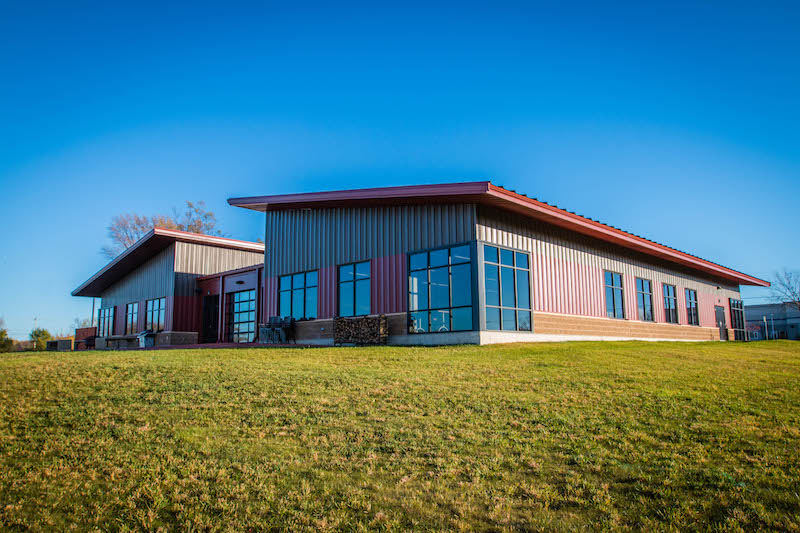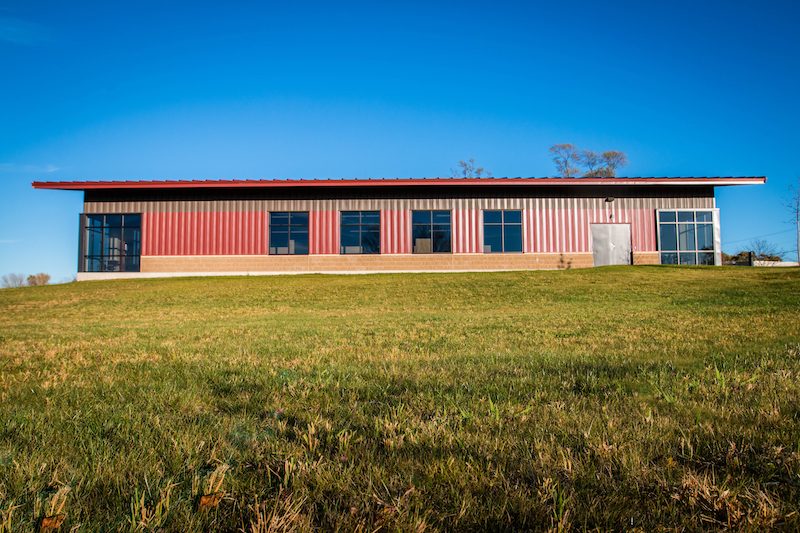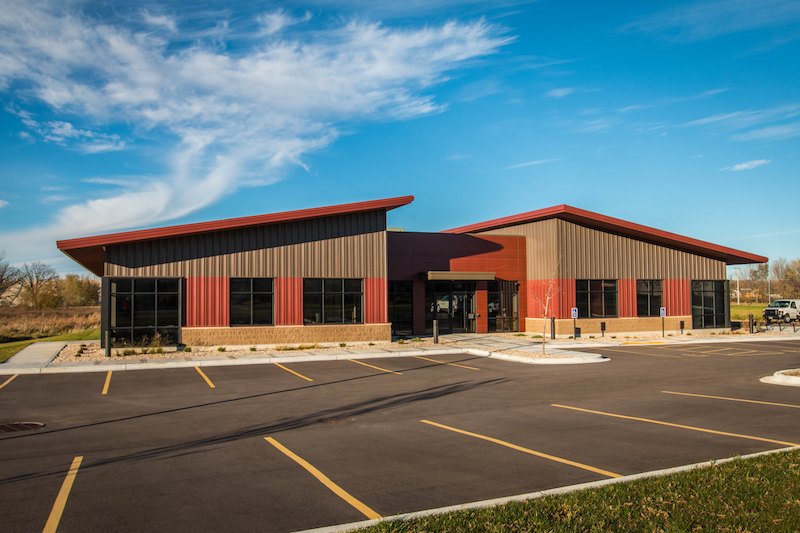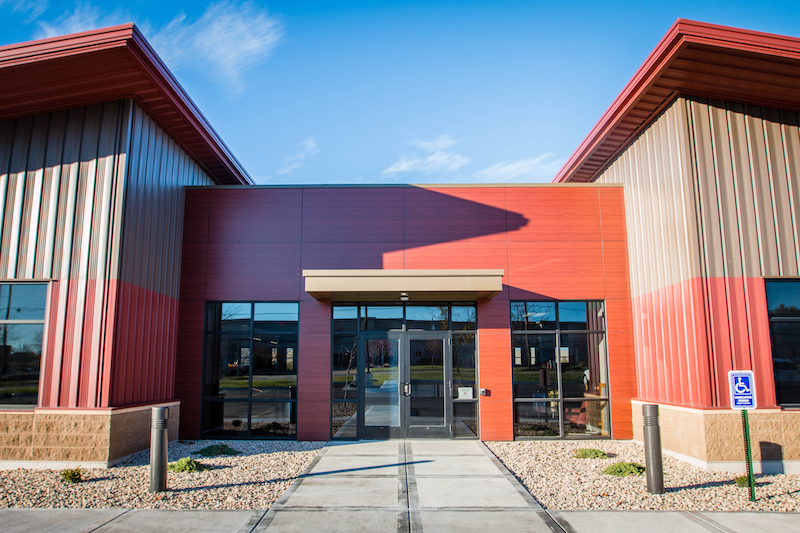TJK Design Build, Inc. of Madison, WI is a company that prides itself on innovative design and outside-the-box approaches to architectural challenges. They frequently build with Star Buildings – often in situations where a metal building is not the usual choice – because TJK has learned that Star is willing to turn their unusual ideas into reality.
The Trane sales office in Madison, WI is a good example. The entire building has a footprint slightly over 10,000 sf. There was no requirement for the kind of broad clear-span area that often drives the decision to use a metal building system. In fact, the modest overall size is actually divided into three sections, and structurally framed as three metal building systems joined together.
According to TJK president Tim Kritter, they chose to make this project a Star metal building for three reasons: cost effectiveness, speed of construction (specifically in relation to the onset of winter), and a flexibility of design afforded by working with Star, which Kritter describes as rare in the industry.

The layout of the building consists of a low-roofed central section with two taller ‘wing’ buildings on either side. (The rising rooflines of the two sides make that term seem more-than-usually appropriate.) The west wing is largely composed of smaller private offices for the sales force. The east wing is a large, open bullpen-type office. The center has the conference room, break room, other common space, and mechanical rooms. Trane HVAC units on the roof of the center section serve all three parts of the building.
The exterior of the Trane office has a dramatic look. The soaring roofs are extended into projection canopies – overhangs five feet long around the sides and 2 feet long at the roof peaks – that help shield the many windows from direct sun. Tim Kritter points out that the aesthetic contribution of overhangs was just as important to the project as solar shading. “They create shadow lines, and give it significant interest.”
The two side-buildings are clad in two colors of AVP 26 ga. metal wall panels, Medium Bronze and Colonial Red. The center section’s exterior is dominated by glazing, surrounded by Trespa panels in colors matching the AVP panels.

If the look of the Trane office is innovative, the structural system that achieves it is probably even more unusual. It could be considered as structurally three buildings, if you look at the rafters. However, it is supported on the number of columns you would expect for two buildings. The center section’s rafters have no columns of their own. They piggyback onto the inner columns of the two wings, supported by means of brackets welded onto the columns. This unusual approach saved on steel and erection time.
Kritter also emphasizes that by using a metal building, they were able to meet a significant challenge in timing. Site work and concrete foundations were begun in October, enabling them to complete concreting before freezing conditions became an issue. This allowed them to have the metal structural frame delivered and erected in December. Because they were able to enclose the building early in the winter, they could work indoors through the rest of the winter to finish the project.

Kritter is enthusiastic about using metal building systems from Star, and reports that it works out advantageously for his company and his customers, even on small projects.
“Star works very, very well with us, allowing us to create these unique shapes and uses, and create enough architectural interest to use a metal building,” comments Kritter. “There are a lot of pre-engineered building manufacturers out there, but we like the ease of creating ideas using Star’s design software. Some metal building manufacturers are just dinosaurs, but Star is willing to allow us to design our building and incorporate elements of architecture back into their system. They’re so good at that, it’s one of the reasons we continue to work with Star.”
Related Stories
| Aug 11, 2010
9 rooftop photovoltaic installation tips
The popularity of rooftop photovoltaic (PV) panels has exploded during the past decade as Building Teams look to maximize building energy efficiency, implement renewable energy measures, and achieve green building certification for their projects. However, installing rooftop PV systems—rack-mounted, roof-bearing, or fully integrated systems—requires careful consideration to avoid damaging the roof system.
| Aug 11, 2010
Pella introduces BIM models for windows and doors
Pella Corporation now offers three-dimensional (3D) window and door models for use in Building Information Modeling (BIM) projects by architects, designers, and others looking for aesthetically correct, easy-to-use, data-rich 3D drawings.
| Aug 11, 2010
AAMA developing product-based green certification program for fenestration
The American Architectural Manufacturers Association is working on a product-based green certification program for residential and commercial fenestration, the organization announced today. AAMA will use the results of a recent green building survey to help shape the program. Among the survey's findings: 77% of respondents reported a green certification program for fenestration would benefit the product selection process for their company.
| Aug 11, 2010
Seven tips for specifying and designing with insulated metal wall panels
Insulated metal panels, or IMPs, have been a popular exterior wall cladding choice for more than 30 years. These sandwich panels are composed of liquid insulating foam, such as polyurethane, injected between two aluminum or steel metal face panels to form a solid, monolithic unit. The result is a lightweight, highly insulated (R-14 to R-30, depending on the thickness of the panel) exterior clad...
| Aug 11, 2010
AIA Course: Enclosure strategies for better buildings
Sustainability and energy efficiency depend not only on the overall design but also on the building's enclosure system. Whether it's via better air-infiltration control, thermal insulation, and moisture control, or more advanced strategies such as active façades with automated shading and venting or novel enclosure types such as double walls, Building Teams are delivering more efficient, better performing, and healthier building enclosures.







